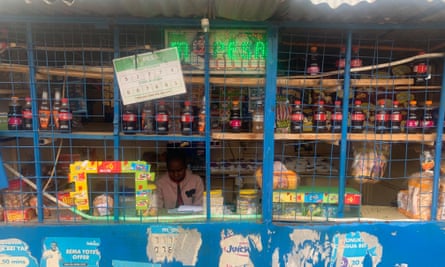A sweet, butter-filled bread roll, neatly wrapped in plastic, has become the snack rickshaw rider Jewel Ahmed reaches for when he needs to eat while stuck in traffic in Bangladesh’s capital, Dhaka.
Bun roti, as the rolls are known, are sold for 10 Bangladesh taka (7p) at the same stalls where the city’s rickshaw riders buy heavily sweetened tea to ward off hunger and tiredness.
“I often eat two or three of these a day with some tea. I still feel hungry sometimes but these usually keep me going for a few hours,” says Ahmed, 27, opening a packet and taking a large bite.
Bangladesh is not the only developing country where snacks are ever more prominent in diets, helping fuel busy workers through the day or children on journeys to and from school, and sometimes even replacing meals. For experts, the rise of unhealthy snack foods is concerning because of potential impacts on long-term health, especially non-communicable diseases such as diabetes and heart conditions.
Ahmed used to eat a far more nutritious diet of fish and vegetables, but rising salinity in the rivers around his coastal home town of Bhola ended his livelihood in fishing and forced him into the city.

“Food in Dhaka is expensive and, with the cost of living crisis, even basic items are now unaffordable,” says Ahmed, who chooses the bun roti over traditional, more substantial snacks such as vegetable-filled shingara pastries. “Because bun roti comes packaged, it stays fresh, and can be eaten easily – especially when my rickshaw is stuck in a traffic jam.”
But snacks like bun rotis tend to offer empty calories without key nutrients. Ahmed, who often eats only one meal a day, has lost weight in the year since he moved to Dhaka. “That’s because these foods give them a quick burst of carbohydrates, but it runs right through them and they need another one,” says nutritionist Barry Popkin, who has observed similar trends in other developing countries as they become more urbanised and industrialised.
Even in rural areas, says Popkin, the move from family farming to industrial agriculture has taken people away from their homes and made them more reliant on quick, often prepackaged and highly processed energy fixes. This has combined with a global spread of snacking, which he says was rare before the 20th century, and increasingly means foods high in sugar and salt.
According to snack manufacturer Mondelez’s 2022 State of Snacking report, 55% of people surveyed around the world eat a meal at least once a week consisting of snack foods – rising to almost two-thirds in Asia.
“That’s a phenomenon that industry sold to us once they started creating ready-to-eat foods and really advertising and pushing it – in the 70s in the US, in the UK a couple years later, and then in Europe,” says Popkin. “It became the norm for adolescents and young adults to eat on the run, snacking at the factory or in the office. This is amazingly common globally now.”
Sales of ultra-processed foods (UPFs) doubled between 2006 and 2019 in developing countries, which food companies have targeted after saturating the market in richer countries such as the US, where 57% of dietary intake is from UPFs.
Popkin, who specialises in research on UPFs, says this has led to a rise in non-communicable diseases globally, especially because of high consumption by children.
New research shows a global rise in cancers in people under 50, a development that experts say may be partly due to diets high in UPFs.
In December 2019, the World Health Organization published a series of articles in the medical journal the Lancet focusing on the “double burden” of malnutrition – overlapping problems with undernutrition and issues such as obesity – calling it a “new nutrition reality” for low- and middle-income countries that the WHO has to adjust to tackle.
“This can exist in the same country but also in the same communities, in the same families and even in the same individuals, often simultaneously,” says Francesco Branca, WHO nutrition director. “Different forms of malnutrition are biologically connected. Somebody who was undernourished in the first period of life, or maybe during conception, is more likely to develop other overweight and non-communicable diseases later in life.”
Branca says snack foods have become increasingly available over recent decades, reaching deeper within countries accompanied by aggressive marketing, especially to children. This creates a food system – the environment for producing and consuming food – that is conducive to bad nutrition and the rise of non-communicable diseases. Such a food system, says Branca, “doesn’t support the accessibility and availability of healthy food but only allows foods which are high in energy but do not provide the adequate amount of, for example, vitamins”.
According to Popkin’s research for the WHO, the double burden of malnutrition has risen fastest in the poorest countries and is most prevalent in sub-Saharan Africa and Asia, while in the 1990s it had been a problem concentrated in higher-income developing countries.
Thomas Reardon, a food system expert at Michigan State University, says the distinction between a snack and a full meal has collapsed because of changing food systems, with small, portable foods becoming an important part of people’s lives. “It is not a snack to them, it’s a cheap and fast meal. [Snacks] have displaced [a traditional meal] sitting down, because of convenience.”
Reardon’s research into rising consumption of processed food in Africa has shown some nutritional benefits, such as greater milk consumption through packaged milks, but that up to a third of it was UPFs that posed challenges to public health.
According to the research, sub-Saharan African and south Asia are the regions where the double burden of malnutrition is most present, affecting 26 countries where efforts to bring down child stunting caused by undernutrition have not kept up with the rise in numbers of overweight and obese people, driven by UPFs.

In Kenya’s capital, Nairobi, the evening rush hour can be when snacks sell best. Lucy Mwenda, 18, who runs a kiosk in a busy area, sells fizzy drinks, sweets, corn snacks and mandazi – a bestselling fried bread snack made by streetside vendors.
Mwedna says it is not just the quick and convenient energy boost they offer, but also the affordability of corn puffs and mandazi – 100 Kenyan shillings (55p) can buy nearly a dozen – that makes them a practical daily option for her customers. “If you can’t afford a kilogram of rice or flour, you buy mandazis and you can still survive,” says Mwendwa, dismissing health concerns as a “secondary” matter.
A customer, 43-year-old business owner Moses Karori, says the other motivation is that snacking has simply become part of everyday life, particularly at schools at break times and at end-of-year “closing day parties”.
“Today was my son’s closing day, and I forgot to buy snacks. I had to go back and get them,” he says. “You have to get them, especially when you have children. It’s a crime to go home without a snack.”
Snack attack: how the west exported unhealthy eating to Africa and Asia - The Guardian
Read More

No comments:
Post a Comment